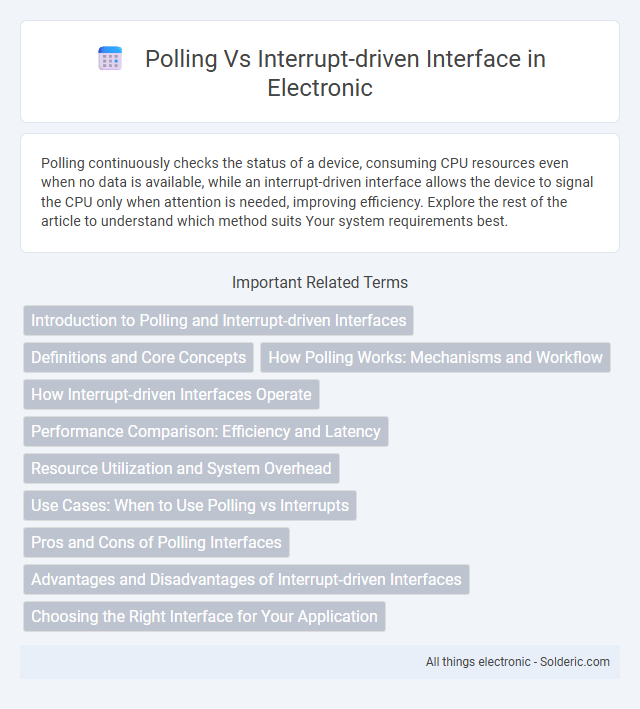Polling continuously checks the status of a device, consuming CPU resources even when no data is available, while an interrupt-driven interface allows the device to signal the CPU only when attention is needed, improving efficiency. Explore the rest of the article to understand which method suits Your system requirements best.
Comparison Table
| Feature | Polling | Interrupt-driven Interface |
|---|---|---|
| Operation | CPU regularly checks device status | Device signals CPU via interrupt |
| CPU Utilization | High, wastes CPU cycles | Efficient, CPU free when idle |
| Latency | Higher, depends on polling interval | Lower, immediate response to events |
| Complexity | Simple implementation | More complex interrupt handling |
| Use Case | Suitable for simple or slow devices | Ideal for real-time or fast devices |
| Power Consumption | Higher, due to constant checking | Lower, CPU sleeps until interrupt |
Introduction to Polling and Interrupt-driven Interfaces
Polling interfaces continuously check the status of a device or resource at regular intervals, consuming CPU cycles even when no events occur. Interrupt-driven interfaces allow devices to signal the processor only when they require attention, improving efficiency by freeing up CPU time for other tasks. Understanding these methods helps optimize your system's responsiveness and resource management.
Definitions and Core Concepts
Polling is a technique where the CPU repeatedly checks the status of an input/output device at regular intervals to determine if it requires attention, leading to continuous CPU involvement regardless of device readiness. Interrupt-driven interface relies on hardware signals sent by the device to notify the CPU of events, allowing the CPU to execute other tasks until interrupted, improving efficiency. Polling consumes more CPU cycles and can introduce latency, while interrupts enable immediate response to device needs with minimal CPU overhead.
How Polling Works: Mechanisms and Workflow
Polling works by continuously checking the status of a device or interface in a repetitive loop to determine if it requires attention or data transfer. The CPU repeatedly queries the device's status registers, which can lead to inefficient processor utilization since it dedicates cycles to constant monitoring rather than executing other tasks. Your system's responsiveness in a polling mechanism depends heavily on the polling rate, as too slow checks can cause delays while too fast checks consume excessive processing power.
How Interrupt-driven Interfaces Operate
Interrupt-driven interfaces operate by allowing hardware devices to signal the processor immediately when they require attention, bypassing continuous status checking. The processor responds by pausing its current task and executing an interrupt service routine (ISR) to handle the device's request, improving efficiency and reducing latency. This mechanism enables faster response times and better CPU utilization compared to traditional polling methods.
Performance Comparison: Efficiency and Latency
Polling interfaces often result in higher CPU utilization because the processor continuously checks the device status, leading to unnecessary resource consumption and increased latency during waiting periods. Interrupt-driven interfaces improve performance by allowing the CPU to execute other tasks and respond immediately when a device signals an event, significantly reducing latency and increasing overall system efficiency. Your system's responsiveness and throughput benefit substantially from using interrupt-driven methods, especially in real-time and high-performance applications.
Resource Utilization and System Overhead
Polling typically consumes more CPU resources since your system continuously checks device status, leading to higher system overhead and inefficient resource utilization. Interrupt-driven interfaces optimize CPU usage by allowing the processor to execute other tasks until an interrupt signals a device's attention, significantly reducing system overhead. Efficient resource utilization in interrupt-driven systems ensures improved performance and responsiveness compared to the constant CPU engagement in polling methods.
Use Cases: When to Use Polling vs Interrupts
Polling interfaces are best suited for simple, low-frequency tasks where processor overhead is minimal and response time is less critical, such as basic input devices or status checks in embedded systems. Interrupt-driven interfaces are ideal for real-time applications and high-speed data transfers, allowing your system to respond immediately to external events without continuous CPU engagement. Choosing between polling and interrupts depends on the specific use case requirements for efficiency, latency, and system complexity.
Pros and Cons of Polling Interfaces
Polling interfaces offer simplicity and straightforward implementation by continuously checking device status, making them suitable for low-speed or less frequent data transfers. However, they consume significant CPU resources and can introduce latency since the processor remains engaged in repetitive status checks rather than handling other tasks efficiently. Your system may experience reduced performance during intensive polling, especially in scenarios requiring timely response to multiple peripherals.
Advantages and Disadvantages of Interrupt-driven Interfaces
Interrupt-driven interfaces offer efficient CPU utilization by allowing your system to respond immediately to external events without constant checking, reducing wasted processing power. However, they introduce complexity in programming and hardware design, requiring careful management of interrupt priorities and potential issues like interrupt latency and nested interrupts. Despite these challenges, interrupt-driven systems are ideal for real-time applications where timely response is critical.
Choosing the Right Interface for Your Application
Polling interfaces continuously check the status of a device, making them suitable for simple applications where latency is less critical and system resources are abundant. Interrupt-driven interfaces respond immediately to hardware signals, optimizing performance and power efficiency in real-time or resource-constrained environments. Choosing the right interface for your application depends on balancing responsiveness requirements and system overhead to ensure optimal operation.
Polling vs Interrupt-driven interface Infographic

 solderic.com
solderic.com